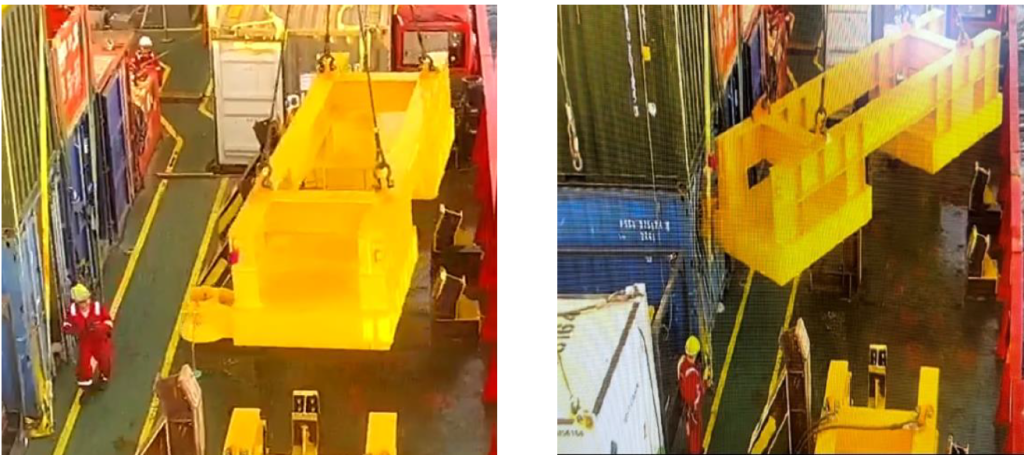Line of fire near miss during lifting operations
What happened
A member of the deck crew member put themselves in the line of fire during landing of a structure on the back deck of a vessel. The installation aids (bumper bars) were insufficient to stabilise the load, resulting in the structure being landed narrowly missing the individual, and damaging an adjacent container. The bumper bars were a critical barrier for keeping the banksman safe on the walkway but as they were not spaced far enough apart for the structure, they allowed a rotational movement of the load.

What went right
- Before landing the structure, the area had been barriered off and non-essential personnel removed from the area;
- All the containers were checked to ensure no-one was working inside them during the lift.
What went wrong
- The individual was focused on landing the structure in a tight space and was relying on the bumper bars to keep him safe in the event of unplanned movement of the structure;
- Even though the design of the installation aids (bumper bars) was within the vessel’s design code, they were not there to protect people, but there as aids to landing and moving structures around the deck without damage. As they were not designed for personnel protection, the distance between them was not considered.
Lessons and actions
- There was a general misconception that installation aids can be used as personnel protection devices, but this is not their design nor their appropriate use;
- Moving the counterweight location and bumper bars was seen as an improvement by the vessel team and therefore they did not go through a Management of Change (MOC) process. Even perceived improvements may have negative consequences and need to be managed;
- Despite all the good work done in pre-job planning, the banksman still put himself in the line of fire. In hindsight, this area should have been a complete no-go zone.
- Take into account when planning work, the difference between “work as imagined” and work as actually done;
- Remain aware of your close environment and understand that during lifting activities, the exclusion zone may change;
- Review tasks where installation aids are being relied on for personnel protection. Should a wider exclusion zone be put in place for these tasks?
Members may wish to refer to:
Safety Event
Published: 18 December 2023
Download: IMCA SF 29/23
IMCA Safety Flashes
Submit a Report
IMCA Safety Flashes summarise key safety matters and incidents, allowing lessons to be more easily learnt for the benefit of all. The effectiveness of the IMCA Safety Flash system depends on Members sharing information and so avoiding repeat incidents. Please consider adding [email protected] to your internal distribution list for safety alerts or manually submitting information on incidents you consider may be relevant. All information is anonymised or sanitised, as appropriate.
IMCA’s store terms and conditions (https://www.imca-int.com/legal-notices/terms/) apply to all downloads from IMCA’s website, including this document.
IMCA makes every effort to ensure the accuracy and reliability of the data contained in the documents it publishes, but IMCA shall not be liable for any guidance and/or recommendation and/or statement herein contained. The information contained in this document does not fulfil or replace any individual’s or Member's legal, regulatory or other duties or obligations in respect of their operations. Individuals and Members remain solely responsible for the safe, lawful and proper conduct of their operations.
